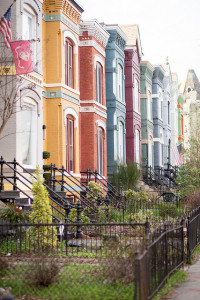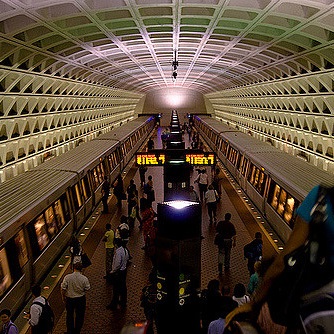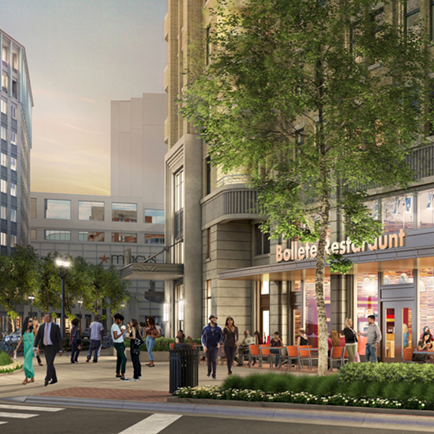[box]
 [featured]Friends -[/featured]
[featured]Friends -[/featured]
I can’t ever say it enough. Thank you!
Your support is why the Coalition for Smarter Growth can fight for better transportation, less sprawl, more walkable neighborhoods, and convenient housing that everyone can afford. Donors like you are increasingly important to the future of CSG.
It’s been a busy time with major issues for smart growth, so I wanted to share with you highlights from our work during the second quarter of 2016:
- Our Metro campaign
- The case for transit-oriented development
- Our popular Walking Tours & Forums Series
- Good land use and transit
- More affordable homes
- Better bicycling
- The right metrics for transportation
Thank you again for your support!
Sincerely,
Stewart Schwartz
Executive Director
[/box]
[box]
Our Metro campaign 
This spring, seldom has a day gone by where we haven’t been communicating about Metro or meeting with decision-makers to identify needed improvements and funding solutions. When WMATA announced SafeTrack, we pressured local jurisdictions to provide effective alternatives and to take the opportunity to test transit enhancements like dedicated bus lanes. We solicited suggestions from our members, hundreds of whom shared their ideas with decision-makers.
As regional authorities scrambled to communicate commuting alternatives, we quickly created and posted our own comprehensive information resource center, highlighting bus, carpool, and bicycling options.
And now, we’re partnering with Greater Greater Washington and WMATA on a contest called MetroGreater, to crowdsource ideas for improvements WMATA can make. The contest is open through July 15 and has already attracted over 1000 entries!
We’re one of just two non-profit groups who’ve been invited to participate in two Metro leadership summits, researching lessons-learned from other major transit systems and identifying solutions for WMATA.
[clear][/box]
[box]
 The case for transit-oriented development
The case for transit-oriented development
New homes near good transit are more important than ever for much needed housing, while reducing traffic and fighting climate change. We made the case for transit-oriented development in an OpEd in the Washington Post on July 1.
When a project has smart design, includes affordable housing, makes it easy for residents to go car-free or car-lite, and is responsive to the surrounding community, we lend it our support.
In northeast DC, a project at 680 Rhode Island Avenue would replace an old strip mall with mixed-use homes right at the Rhode Island Avenue Metro station, and it will have a direct connection to the Metropolitan Branch Trail for bicyclists. We rallied support at the DC Zoning Commission, and will be following this great project closely going forward!
In Ballston, a major new LEED-certified project with on-site affordable housing at 750 N. Glebe Road is moving forward thanks in part to our support. The project replaces a car dealership with some great architecture, steps down to the neighborhood, and provides a safer crossing of Glebe Road for pedestrians. Good news: the Arlington County Board approved the site plan on June 18.
Plans to redevelop the Wardman Park hotel site at Woodley Park Metro station are in the works. New proposals include an eight-story, 120-unit multifamily building, and in the longer-term, nearly 1300 new residential units in four buildings with a short walk to Metro. We’re watching the project closely, and we’ll be consulting with our supporters and neighbors as the project moves forward.
[box]
 Our popular Walking Tours & Forums Series
Our popular Walking Tours & Forums Series
We just wrapped up another season of our perennially-popular walking tours! Over 300 people joined us to learn about smart growth in action. The season included Old Town North, Fairfax City, Wheaton, Navy Yard, and Kennedy Street. Up next this summer? DC’s NoMa neighborhood! Professional planners can earn AICP credits on the tours thanks to our partnership with the American Planning Association.
In May, we partnered with CASA for our Faces of Transit forum, a discussion on how coming improvements like bus rapid transit and the Purple Line may impact people of all incomes in Prince George’s and Montgomery Counties. Seven local councilmembers and delegates attended the event, where we hosted two panels – a community panel of low-income residents who depend on transit, and local transit experts on what to expect as these transit projects move forward. [clear][/box]
[box]
 The details matter for good land use and transit
The details matter for good land use and transit
We’ve been weighing in on major land use and transportation planning initiatives to ensure we get the details right:
Rockville officials released plans for Rockville Pike showing how it could become a 252-foot-wide mega-boulevard with 12 car lanes, 4 bike lanes, 2 bus lanes, and large medians. But in trying to do too much with one street planners would create a major barrier to pedestrians and divide the community. We rallied our members and testified for a narrower cross-section like that proposed for the boulevard in White Flint. The Rockville City Council has asked for further analysis, which we’ll be watching for when it’s released in August.
We’re weighing in on a particularly significant policy reform in Montgomery County. The county is updating its growth policy (known as the Subdivision Staging Policy) to encourage — not discourage — transit-oriented development. If passed, the new policy will shift from auto-oriented requirements to crediting new development for increasing the opportunities for Montgomery residents to use transit, walk, and bike. We’re educating the public and rallying support in advance of the final vote this fall.
In DC, east-west travel options between Columbia Heights and Brookland aren’t great, even as significant new development is moving forward. We’ve long called for new transit, bike connections and a transportation management district. DDOT is now considering many improvements including dedicated bike and bus lanes and reconfiguring the cloverleaf at Irving St and North Capitol.
Having won a new transit plan for the Richmond Highway (Route 1) corridor in Fairfax, we are immersed in the process to update the comprehensive plan for the corridor. We lead a broad coalition of transit, smart growth, conservation, and affordable housing groups and are pressing for expanded public engagement, strong affordable housing policies, better stormwater management, parks, and bicycle/pedestrian conditions. Coming up — a coalition meeting with the two Fairfax Supervisors. [clear][/box]
[box]

More affordable homes
In February, we mobilized in Alexandria to support replacing Ramsey Homes with a new building providing 52 new affordable homes within walking distance of Metro, jobs, and services.
Some neighbors had sought historic preservation for some or all of the four aging buildings. In late June the City Council voted unanimously in favor of replacing all four buildings with 52 units of mixed-income, affordable housing.
[box]
 Better bicycling
Better bicycling
Bike investments are part of a regional transportation solution, but not according to some outer suburban state legislators in Virginia. So we’ve campaigned in support of the City of Falls Church’s request for funding for Capital Bikeshare, which will provide an efficient option for connecting residents to the two Metro stations on the city’s border. Our Falls Church members responded enthusiastically to our action alert, sending dozens of emails and catching the attention of officials. Local and state elected officials on the Northern Virginia Transportation Authority (NVTA) and Northern Virginia Transportation Commission (NVTC) are considering the city’s funding requests. We expect a decision in July.
Downtown Silver Spring could become very bike-friendly, with three miles of interconnected, protected bike lanes on Dixon Ave, Wayne Ave, and Fenton Street. But pushback from nearby neighbors and businesses on Fenton St. might stop some bike lanes before the study even begins. Bike lanes make the streets safer for all users, work great for short trips and will enhance the quality of life in Silver Spring. So we’re starting early to rally support for this important infrastructure.
This summer, Alexandria will repave the section of King Street between Janney’s Lane and Radford Street, creating the opportunity to extend cross-city bike lanes. We’ve promoted the possibility of the new bike lanes to our Alexandria members and submitted testimony to the Traffic and Parking Board to make King St. a “Complete Street” that serves everyone: people in cars, on bicycles, taking transit, and walking.
[clear][/box]
[box]
 We need the right metrics for transportation
We need the right metrics for transportation
How we measure matters. The US Department of Transportation has released new requirements for how states and metro areas will have to evaluate transportation projects. These new requirements can help us understand what federal transportation dollars actually accomplish—an absolutely worthwhile goal.
But as originally written, the proposal would prioritize fast driving speeds over the need for safe streets, local economic development, and accessibility to jobs and services. We worked with national partners Smart Growth America and Transportation for America and groups across the US to flood USDOT with letters, asking for amendments to the metrics. There’s still time to send your own email! [clear][/box]
[clear]
images: top rowhouses/Aimee Custis, Metro/Mike on Flickr, 750 N. Glebe/Saul Centers, Walking tour/Aimee Custis, Silver Spring/Dan Reed on Flickr, Ramsey Homes/Aimee Custis, Bike lanes/Dan Reed on Flickr, Highway/Stephen Lee Davis.


